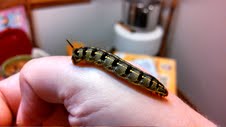UPDATE: Laura Jesse, entomologist with Iowa State University Extension, said while she is not 100 percent certain from the photograph, it appears the mystery caterpillar is what several of us suspected: a white-lined sphinx moth. “They have a lot of variability,” she noted, and sent along this link: http://bugguide.net/node/view/3071
Previous post: A Homegrown reader is stumped by a caterpillar she found in her garden in east-central Iowa and is looking for identification help.
My guess is a white-lined sphinx moth caterpillar, but I’m hoping that someone who knows for sure can help her out.
Here is what she wrote: “I found this caterpillar in my garden last night. I searched around on the Internet and didn’t have any luck. It isn’t a black swallowtail. I found those earlier this fall in my parsnips. I was wondering if it is a type of cutworm or cankerworm? (Bad for my garden, either way!)
Possible habitat: I found it clinging to a basil plant…next to a row with parsley. There is also an ash tree nearby.
Markings: Black, bright green, a bit of yellow. Tan face and 1 tail (?) in the back. Hairless. A lot of the cutworms I found on the internet mentioned brown. It doesn’t have any brown.
Mannerisms: When I picked it up it didn’t really curl into a ball, like I read that some cutworms do. It’s pretty ballsy and will arch up and check you out. I didn’t notice any particular smelly poop when I picked it up, either. It pooped a lot, though.
Either way, I brought it in for my daughter’s butterfly cage to see if we can get it to form a chrysalis. I threw in some parsley for it to climb/possibly eat but it would be nice to find out what it really wants to eat so I don’t starve it to death!”
In case it is a sphinx moth caterpillar, a blog post I found has tips for raising these, from Growing with Science: In the update I mentioned that I had placed a caterpillar in a terrarium with moist potting soil (about five inches deep). The caterpillar immediately disappeared, but I knew where it had gone. Large moth caterpillars, like white-lined sphinx moth caterpillars or tomato hornworms, dig into the soil before pupating. Their pupa looks like a dark reddish-brown cigar. Saturday I found the moth sitting on the cloth I had used to cover the terrarium. It had successfully emerged.
I know my readers always come through, so if anyone can positively identify this, please leave your suggestions in a comment here or on the Homegrown Facebook page.


No Comments Yet